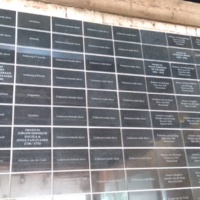
Solms Delta
Solms Delta is a wine estate, situated east of Cape Town in the heart of the Cape Winelands. It was founded as Zandvleit in 1690, with the name change coming in 2002 after purchase by University of Cape Town-based neurosurgeon Mark Solms who wished to distinguish it from other farms with the same name. As with the majority of South African wine farms of a similar age, its early labour force rested on enslavement. Solms approach to farm ownership has seen him attempt to eschew the well-worn white owner/black worker relationship by launching a socio-economic reform project. Money has been invested in new housing featuring satellite television, whilst an education project both for workers and their children has been established. Social enrichment activities based around music, sports, and performance have been encouraged in an attempt to improve the traditionally poor socio-economic circumstances of the workers, many of whom live on the estate just as their ancestors did. Solms has explained in interviews that this refreshed approach to wine farming arises from a perceived responsibility to acknowledge his own life privileges as a white South African. Crucially, workers have been given shares in a land equity scheme.
Solms Delta hosts two museums. One of these, named Museum van de Caab with deference to Cape slave naming patterns, opened at the same time as the estate opened to the public in 2005, with a music museum opening in 2014. Acknowledgement of the past as a means of understanding how workers have been exploited over time is a crucial part of Solms’ project. Slavery is referenced in both museums, with songs as evidence of slave culture appearing in the music museum. In Museum van de Caab it forms a fundamental part of a general farm history which traces the story of the land to the origins of humankind. A memorial feature occupies a prominent position in one of two galleries, detailing the names of every person revealed by archival research to have been enslaved on the estate. Guided museum and estate tours are available, conducted by estate workers.
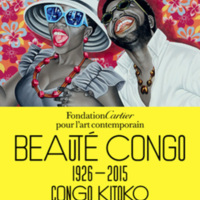
Beauté Congo – 1926-2015 – Congo Kitoko, Fondation Cartier, Paris (11 July 2015 - 10 January 2016)
A place of extraordinary cultural vitality, the creative spirit of the Democratic Republic of the Congo will be honored in the exhibition Beauté Congo – 1926-2015 – Congo Kitoko presented at the Fondation Cartier pour l’art contemporain with André Magnin, Chief Curator.
Modern painting in the Congo in the 1920s: Taking as its point of departure the birth of modern painting in the Congo in the 1920s, this ambitious exhibition will trace almost a century of the country’s artistic production. While specifically focusing on painting, it will also include music, sculpture, photography, and comics, providing the public with the unique opportunity to discover the diverse and vibrant art scene of the region.
Precursors: As early as the mid-1920s, when the Congo was still a Belgian colony, precursors such as Albert and Antoinette Lubaki and Djilatendo painted the first known Congolese works on paper, anticipating the development of modern and contemporary art. Figurative or geometric in style, their works represent village life, the natural world, dreams and legends with great poetry and imagination. Following World War II, the French painter Pierre Romain-Desfossés moved to the Congo and founded an art workshop called the Atelier du Hangar. In this workshop, active until the death of Desfossés in 1954, painters such as Bela Sara, Mwenze Kibwanga and Pili Pili Mulongoy learned to freely exercize their imaginations, creating colorful and enchanting works in their own highly inventive and distinctive styles.
Popular painters: Twenty years later, the exhibition Art Partout, presented in Kinshasa in 1978, revealed to the public the painters Chéri Samba, Chéri Chérin, and Moke and other artists, many of whom are still active today. Fascinated by their urban environment and collective memory, they would call themselves “popular painters.” They developed a new approach to figurative painting, inspired by daily, political or social events that were easily recognizable by their fellow citizens. Papa Mfumu’eto, known for his independent prolific comic book production and distribution throughout Kinshasa in the 1990s, also explored daily life and common struggles throughout his work. Today younger artists like J.-P. Mika and Monsengo Shula, tuned-in to current events on a global scale, carry on the approach of their elders.
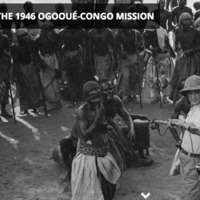
In the Footsteps of the 1946 Ogooué-Congo Mission, Online Exhibition, Europeana Collections
In 1947, 70 years ago, the public discovered one of the first sound recordings of Pygmy music collected in Equatorial Africa by the French ethnomusicologist Gilbert Rouget.
These were recorded during the Ogooué-Congo Mission, a scientific expedition led by the 23-year old French ethnologist Noël Ballif. This mission was the first organised by the Liotard group, a collective of young French explorers from Paris’ Musée de l’Homme.
From July to December 1946, the 12 members of the expedition travelled across the former Middle Congo (the current Republic of the Congo) and Gabon. They spent six weeks completely immersed in Bambinga Pygmy tribes from the Haute Sangha region, in the North of Moyen Congo - an experience that turned out to be decisive for some of them.
Whether they are sound recordings, photographs, films, artifacts or scientific studies, the documents collected and produced during and after the Ogooué-Congo Mission allow us to discover their adventure.
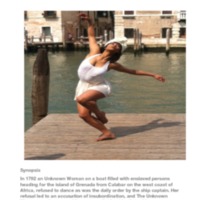
The Woman Who Refused to Dance
In Autumn 2007, the opera 'The Woman Who Refused To Dance' by composer and conductor Shirley J Thompson was performed at Westminster Palace, Houses of Parliament. The piece was based on a 1792 print by Isaac Cruickshank - entitled 'The abolition of the slave trade, or the inhumanity of dealers in human flesh exemplified in the cruel treatment of a young negro girl of 15 for her virgin modesty' - depicting a woman who refused to dance on board a slave ship, and who was hung from one leg as punishment. The opera has recently been re-premiered to mark the 210th anniversary of the abolition of the transatlantic slave trade.
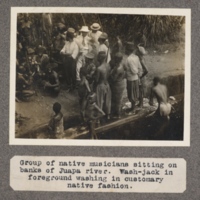
Group of native musicians sitting on banks of Juapa River. Wash Jack in foreground washing in customary native fashion
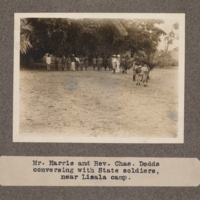
Mr. Harris and Rev. Chas. Dodds conversing with state soldiers, near Lisala camp
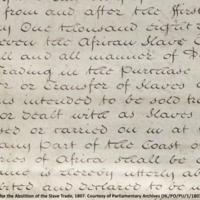
Heartbeat Riddim Chant
The dance-theatre production Heartbeat Riddim Chant was based on the horrors of the transatlantic slave trade. The production premiered at the West Yorkshire Playhouse in Leeds in July 2007, and mixed dance, live music and voice, including traditional Caribbean folk dancing blended with contemporary reggae. The show was choreographed by David Hamilton, and featured dancers from Regeyshun Dance and members of the community dance group Back Bone. There were also performances from youth dance groups and young voices from across Leeds, including LS7 Result, Northern School of Contemporary Dance, Gee4orce and Leeds Young Authors.
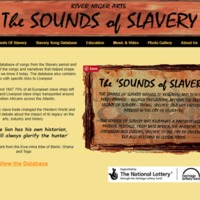
The Sounds of Slavery
The Sounds of Slavery was a project by the performance and visual arts group River Niger Arts to research, record and develop a performance-related programme around the musical heritage and legacy of slavery. The project took particular interest in these themes in relation to the City of Liverpool, but also addressed them in global terms. The project created a database of songs and narratives from the period of slavery. Members of the River Niger Orchestra also performed at a Sounds of Slavery performance at Liverpool Hope University. Some of the songs performed included 'The Chase', 'No More Auction Block' and the African American spiritual 'The Jubilee Song'. The project was accompanied by a series of performance and visual arts education workshops with schools.
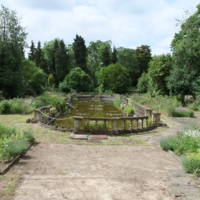
Liberation Song
Easton Lodge is a historic estate in Essex, with gardens open to the public. The Gardens of Easton Lodge Preservation Trust led two projects to mark the bicentenary. Liberation Song involved three local schools working with Grand Union Orchestra to explore the roots of musical instruments and styles, culminating in a community concert. A visual arts project involving seven local schools examined the history of Easton Lodge and trading links during the 18th century. Children decorated and displayed cotton reusable carrier bags and displayed them on yew hedges in the gardens. Connections were made with the story of the 18th century Ghanaian anti-slavery campaigner Ottobah Cugoano and the modern day Fair trade movement.
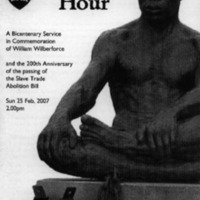
The Better Hour: A Bicentenary Service in Commemoration of William Wilberforce
A bicentenary service in commemoration of William Wilberforce and the passing of the 200th anniversary of the Abolition Act took place in February 2007 at York Minster. The service featured Pocklington School Choir, Transglobal Drummers and the Riding Lights Theatre Company (performing extracts of the play African Snow). Organisations associated with the service included Churches Together in England and the Set All Free project, and the Wilberforce Institute for the study of Slavery and Emancipation at the University of Hull

Did Slavery End in 1807?
An evening of presentations and music organised by Fife Workers' Educational Association, examining Fife and Scotland's role in the slave trade and abolition, and efforts to end contemporary slavery.
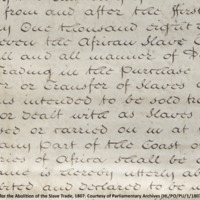
Remembering Slavery: A Musical Journey
Remembering Slavery: A Musical Journey was a performance at Luton's summer festival in July 2007. Young people told the story of slavery through music from Africa to the Caribbean to South America.
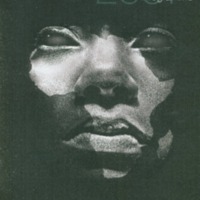
2007 Bicentenary for the Abolition of the Slave Trade Act at the National Maritime Museum
The National Maritime Museum marked the bicentenary with a range of initiatives and events including a new exhibition, a film season, poetry, music, debates, and new publications. A new permanent gallery opened at the museum in winter 2007 exploring Britain's Atlantic empire. A catalogue of slavery-related images, artefacts and documents from the collections of the museum, 'Representing Slavery', was published. The museum also devised a transatlantic slavery trail around Greenwich.
The National Maritime Museum hosted a number of events throughout 2007. The theme of the weekend 23-25 March was 'And still I rise', marked with a series of activities, performances and discussion. On August 23, International Day for the Remembrance of the Slave Trade and its Abolition, the ‘Freedom Festival: Contemporary Commemoration’ event saw a programme of creative events and performances exploring themes around the heritage of enslavement. The museum also offered a range of learning experiences based on its collections. For example, in November, a study session, 'Roots of Resistance: Abolition 1807' examined the roots of resistance and the abolition movement through talks by curators and contemporary artists. Activities for families were based on themes of freedom and carnival. 'The Big Conversation 2007' was a programme of debate and showcasing of diverse projects undertaken by students around the country, organised by the Understanding Slavery Initiative and the Department for Children, Schools and Families.
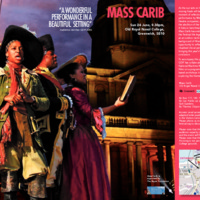
Mass Carib
Mass Carib is a choral performance piece written by Felix Cross. In 2007 it was performed outdoors at the Royal Naval College in Greenwich by Nitro Theatre Company, as a finale to the Greenwich and Docklands International Festival. To accompany the performance, the festival collaborated with the National Maritime Museum and Nitro on a programme of workshops in schools in Greenwich exploring the themes of the production. Mass Carib was written as a Requiem using the liturgical form of the Catholic Mass. It draws on music from West Africa, eighteenth-century Europe and various Caribbean islands. Mass Carib is sung in English, French, Patois, Latin and Yoruba.
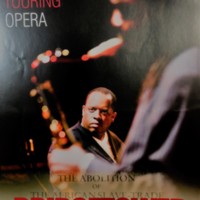
Bridgetower - A Fable of 1807
Bridgetower - A Fable of 1807 is a jazz opera composed by jazz pianist Julian Joseph, with libretto by author Mike Phillips. It was commissioned for the City of London Festival's bicentennial commemoration of the Abolition Act. The opera recreates the story of the Afro-European violinist George Polgreen Bridgetower (1778-1860), who was born into slavery, became a friend of Beethoven and was acclaimed throughout Europe for the standard of his playing. The opera was directed by Helen Eastman and toured by English Touring Opera. It opened during the 2007 City of London Festival at London Symphony Orchestra St Luke's, and later toured venues around the UK. Each performance featured a local community choir, with members drawn from local amateur choirs.
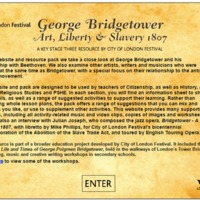
George Bridgetower: Art, Liberty and Slavery 1807
In this website and Key Stage 3 Resource Pack, the City of London Festival examined the work of the Afro-European violinist George Bridgetower (1778-1860) and, in particular, his relationship with the composer Ludwig van Beethoven. The resource also explored the role of other artists, writers and musicians who were active at the same time as Bridgetower, with a special focus on their relationships to the anti-slavery movement. The website provided music, video clips and worksheets, alongside an interview with Julian Joseph, composer of the jazz opera Bridgetower - A Fable of 1807, toured by English Touring Opera. The resource was part of a broader education project developed by City of London Festival, which included the exhibition, 1807: The Life and Times of George Polgreen Bridgetower, held in the walkways of London's Tower Bridge. The education project also included storytelling, music and creative writing workshops in secondary schools.
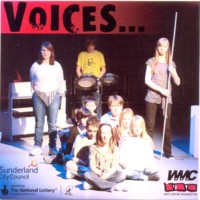
Voices...
A collaborative project between Arts Centre Washington's Youth Theatre and Washington Music Collective, providing development of live music activities for young people within Washington and the surrounding areas. The project involved improvisation, creative writing, music and drama workshops for young people during school holidays, and culminated in a thirty minute play around the themes of slavery. A DVD was produced featuring musical shorts and video diaries of the young actors' experiences. One theme covered was the limbo dance, originating in Trinidad and Tobago, and with symbolic links to enslaved people entering the galleys of a slave ship.
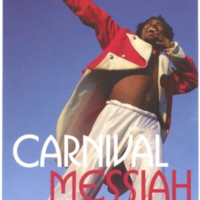
Carnival Messiah at Harewood
2007 saw a number of different projects taking place at Harewood House in West Yorkshire, home of the Lascelles family. The bicentenary was used as an opportunity to explore the family connections with the transatlantic slave trade and the sugar plantations of the West Indies.
To spotlight Harewood House's historic links with the Caribbean and carnival, in September 2007 a production of Carnival Messiah was held in a Big Top in the grounds. Carnival Messiah is a reinvention of George Frideric Handel’s oratorio Messiah as carnival theatre and heritage experience. The West Indian celebration features dancers, singers, masqueraders, musicians and actors. Stories from the Caribbean folk tradition, medieval mystery plays and African ritual combine with contemporary popular music and dance styles, including gospel, calypso, reggae, jazz, hop hop, bhangra and steel band. Geraldine Connor was Creator and Artistic Director and David Lascelles of Harewood House was Executive Producer. A community education and outreach programme ran alongside the project.
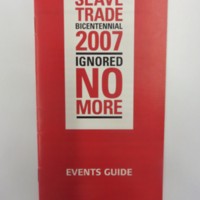
Abolition of the Slave Trade Bicentennial 2007: Ignored No More
The Greater London Authority produced an Events Guide for Londoners in 2007 detailing some of the initiatives taking place in the capital involving the Mayor. This included Africa Day on Trafalgar Square, celebrating the positive contributions of London's African communities, and 'Rise: London United', an anti-racist music festival. The conference 'Faith Symposium: In God's Name?' at City Hall examined the role of the Church in the transatlantic slave trade. There was also a seminar on the legacies of the transatlantic slave trade from a Caribbean perspective and a Caribbean Publishers Book Fair held at London Metropolitan University. The Dr Eric E. Williams Memorial Lecture Series at City Hall was made available as a webcast.
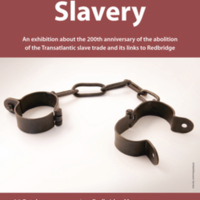
Redbridge and Slavery
Redbridge Museum's exhibition to mark the bicentenary examined the London Borough of Redbridge's connections to the slave trade and abolition. These links included local resident Josiah Child, once Governor of the East India Company, an investor in the Royal African Company and owner of plantations in Jamaica. The Mellish family of Woodford had connections with the West India Docks in London, built for the sugar trade. Alexander Stewart of Woodford owned Jamaican plantations and acted on behalf of owners of enslaved Africans in compensation claims after abolition. The exhibition also examined church records detailing some of the Black residents of Redbridge in the 17th and 18th centuries. Music from the Caribbean island of Dominica was included, as was a series of personal responses to the bicentenary by local residents.